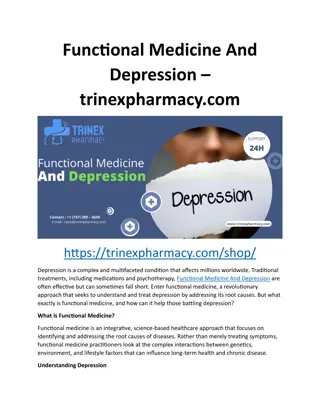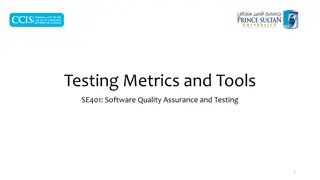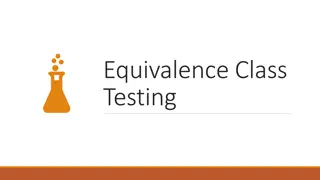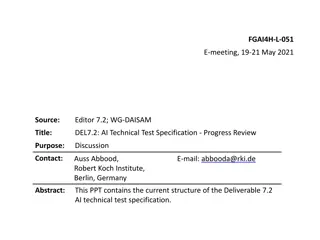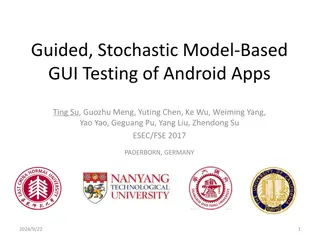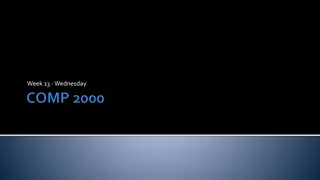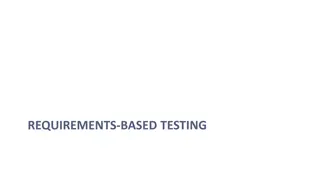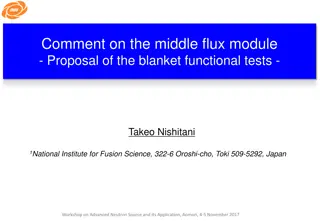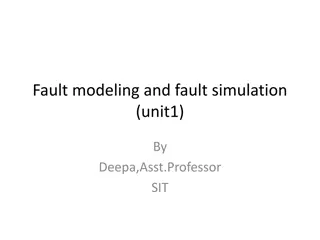Functional Testing Strategies and Tools Overview
Explore functional testing concepts, strategies, and tools through a collection of detailed images covering topics such as mock objects, unit testing, test environments, and testing in production. Learn about mocking dependent services, modes of communication, and strategies for testing in various environments.
Download Presentation

Please find below an Image/Link to download the presentation.
The content on the website is provided AS IS for your information and personal use only. It may not be sold, licensed, or shared on other websites without obtaining consent from the author.If you encounter any issues during the download, it is possible that the publisher has removed the file from their server.
You are allowed to download the files provided on this website for personal or commercial use, subject to the condition that they are used lawfully. All files are the property of their respective owners.
The content on the website is provided AS IS for your information and personal use only. It may not be sold, licensed, or shared on other websites without obtaining consent from the author.
E N D
Presentation Transcript
Mock Objects in Functional Testing Sven Rosvall
Dimension Data Cloud Business Unit
Functional Testing Test Frame- work
Mocking Dependent Services Goals: Mimic required functionality for testing Easy to maintain and to deploy Verify requests Control expected responses Remove indirect dependencies
Modes of communication Synchronous Requests Asynchronous Messages Files Shared memory Database updates and triggers
Mocking an HTTP service Simple mock HTTP service Mock Service Test Harness Embedded HTTP service within test program Test Harness Mock Service
WireMock @Rule public WireMockRule wireMockRule = new WireMockRule(PORT); String responsePayload = fromFile("GetDeviceResponse_ok.json"); stubFor(get(urlEqualTo("/api/device?limit=100" + "&filter.component_unique_id=" + vmRefId + "&filter.component_root_device=" + vcenterDID)) .withHeader("Authorization", equalTo("Basic " + new String(basicAuth, Charset.forName("UTF-8")))) .willReturn(aResponse() .withHeader("Content-Type", "application/json") .withStatus(HttpStatus.SC_OK) .withBody(responsePayload)));
Asynchronous Communication Test Harness
Proprietary Communication Protocol is hidden in a client library. Protocol is verbose and complex.
Solution: Mock Client Library Test Harness Mock Client
Mock Client Library Use a back door connection for: Response data Inspecting request data Control exceptions Backdoor runs in its own thread. May require care when serializing data. Use same technology as is used for the service s inputs.
Application state Stateless Stateful State kept in some dependent service. State kept in application. No need to set up state before each test case. Run application functionality to set state correctly for each test. Run test cases in any order. or ... Run tests in specific order to use state set in previous tests.
Database Usage Database stores state. Database as part of the application? Resetting content between tests. Mocking Database Access Layer
Database and Application Database is a part of the application Database is a dependent service ORM make database schema tightly coupled to the application. Database developed independently of application internal structures. Don t let schema bleed into the test code. Test code is allowed full access to database
Database Preparation Use a golden image of database for quick start. May contain lots of static data. Recreate schema and data Recreate data only Roll-back data changed during test Prepare test specific data Tests that don t update database
Inputs and outputs For a stateless service Identify input stimuli and the side effects they cause. Split each scenario to include one stimulus only.
Input Stimuli HTTP requests Messages Database triggers File creation


